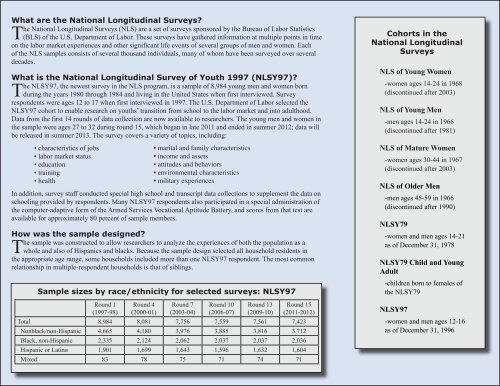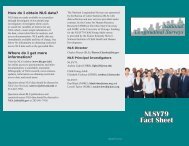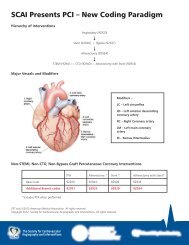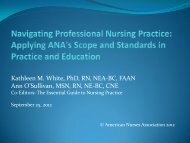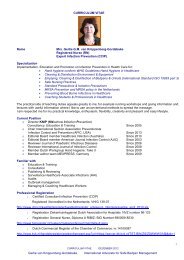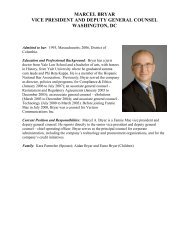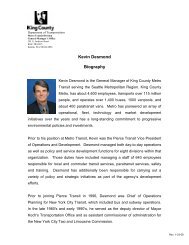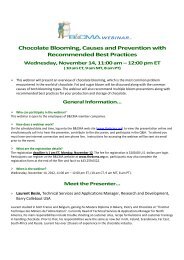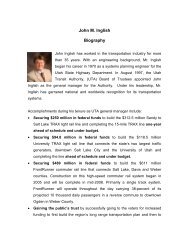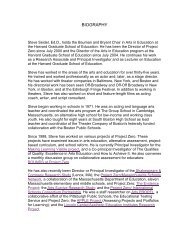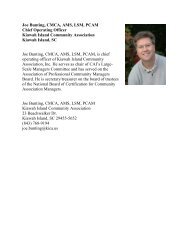NLSY97 Fact Sheet
NLSY97 Fact Sheet - CommPartners
NLSY97 Fact Sheet - CommPartners
- No tags were found...
Create successful ePaper yourself
Turn your PDF publications into a flip-book with our unique Google optimized e-Paper software.
What are the National Longitudinal Surveys?The National Longitudinal Surveys (NLS) are a set of surveys sponsored by the Bureau of Labor Statistics(BLS) of the U.S. Department of Labor. These surveys have gathered information at multiple points in timeon the labor market experiences and other significant life events of several groups of men and women. Eachof the NLS samples consists of several thousand individuals, many of whom have been surveyed over severaldecades.What is the National Longitudinal Survey of Youth 1997 (<strong>NLSY97</strong>)?The <strong>NLSY97</strong>, the newest survey in the NLS program, is a sample of 8,984 young men and women bornduring the years 1980 through 1984 and living in the United States when first interviewed. Surveyrespondents were ages 12 to 17 when first interviewed in 1997. The U.S. Department of Labor selected the<strong>NLSY97</strong> cohort to enable research on youths’ transition from school to the labor market and into adulthood.Data from the first 14 rounds of data collection are now available to researchers. The young men and women inthe sample were ages 27 to 32 during round 15, which began in late 2011 and ended in summer 2012; data willbe released in summer 2013. The survey covers a variety of topics, including:• characteristics of jobs• labor market status• education• training• healthIn addition, survey staff conducted special high school and transcript data collections to supplement the data onschooling provided by respondents. Many <strong>NLSY97</strong> respondents also participated in a special administration ofthe computer-adaptive form of the Armed Services Vocational Aptitude Battery, and scores from that test areavailable for approximately 80 percent of sample members.How was the sample designed?The sample was constructed to allow researchers to analyze the experiences of both the population as awhole and also of Hispanics and blacks. Because the sample design selected all household residents inthe appropriate age range, some households included more than one <strong>NLSY97</strong> respondent. The most commonrelationship in multiple-respondent households is that of siblings.Sample sizes by race/ethnicity for selected surveys: <strong>NLSY97</strong>Round 1(1997-98)Round 4(2000-01)• marital and family characteristics• income and assets• attitudes and behaviors• environmental characteristics• military experiencesRound 7(2003-04)Round 10(2006-07)Round 13(2009-10)Round 15(2011-2012)Total 8,984 8,081 7,756 7,559 7,561 7,423Nonblack/non-Hispanic 4,665 4,180 3,976 3,885 3,816 3,712Black, non-Hispanic 2,335 2,124 2,062 2,037 2,037 2,036Hispanic or Latino 1,901 1,699 1,643 1,596 1,632 1,604Mixed 83 78 75 71 74 71Cohorts in theNational LongitudinalSurveysNLS of Young Women-women ages 14-24 in 1968(discontinued after 2003)NLS of Young Men-men ages 14-24 in 1966(discontinued after 1981)NLS of Mature Women-women ages 30-44 in 1967(discontinued after 2003)NLS of Older Men-men ages 45-59 in 1966(discontinued after 1990)NLSY79-women and men ages 14-21as of December 31, 1978NLSY79 Child and YoungAdult-children born to females ofthe NLSY79<strong>NLSY97</strong>-women and men ages 12-16as of December 31, 1996


